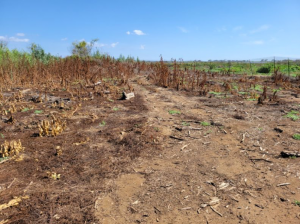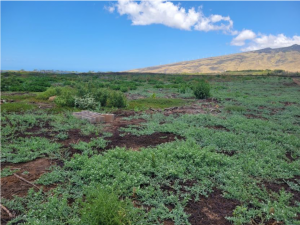Reef Friendly Landscaping Comes to Kealia Pond National Wildlife Refuge
Through the generosity of the Flora Family Foundation’s grant award, MNMRC was able to expand the RFL program to a new sector, Keālia Pond National Wildlife Refuge. As one of Maui’s last remaining intact wetlands, and a vital piece of a
healthy functioning coastal ecosystem, Keālia Wetland is an ideal location to demonstrate the efficacy of treating the land with organic methods to produce desired landscape results while mutually benefiting the surrounding environment.
The RFL program initiated a test plot at the Keālia Pond National Wildlife Refuge in partnership with Environmental Solutions Maui, the company that produces the soil amendment and performs soil monitoring. The test plot aims to support native plant restoration and reduce reliance on chemical pesticides to combat invasive weeds.

Kealia Pond restoration plot with invasive species removed prior to revegetation work.
One of the primary interests of this project is to assess the effectiveness of these amendments in controlling weed growth in a protected area, as an alternative to synthetic chemicals. Scientific research consistently demonstrates that mycorrhizal fungi improve soil structure by binding soil particles together, forming stable aggregates, and
enhancing aeration. These fungi also establish symbiotic relationships with plant roots, improving nutrient availability and stress tolerance, creating a more favorable environment for plant growth. Weeds that thrive in low-nutrient conditions are less likely to form these beneficial bonds, giving an advantage to native plants that succeed them in ecological succession. Additionally, some studies have shown that weeds forming mycorrhizal bonds can be adversely affected by them, as they struggle to regulate nutrient exchange effectively. With these principles in mind, our pilot project aims to determine if we can assist native plant species in competing with or surpassing the invasive species that currently require herbicide use. If successful, this approach could reduce the need for manual weeding and save labor hours.

Kealia pond restoration plot with native wetland plants.
Another essential aspect of improving soil structure is increasing water retention capacity, leading to water conservation and improved drought tolerance. Enhancing the soil’s ability to retain water can support sustainable water usage in the
protected area. Our overarching goal is to develop a sustainable system that optimizes soil health while being environmentally friendly and economically viable within the protected area.
Although the test plot is still in progress, preliminary and intermediate soil samples have shown increases in soil microbiology, supporting plant health and creating more favorable environments for native plants to thrive. Over the coming four months, SoilThrive will be delivered to the staff at Keālia to apply the amendment at an application rate of 50 gallons per week for three weeks in the inoculation phase, and then one time per month for the remaining three months. Additional soil samples will be taken to assess the success of establishing the microbes, as well as final soil samples at the end of the four-month test plot period.



No Comments
Sorry, the comment form is closed at this time.